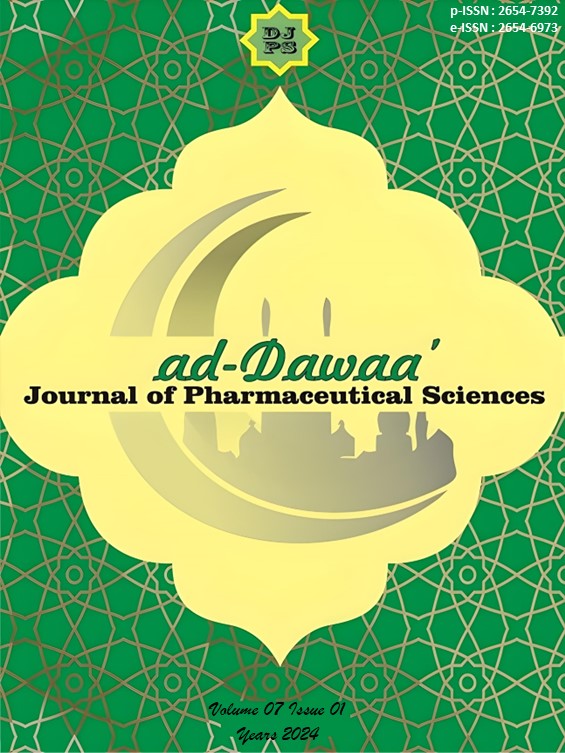Aaptamine Enhanced Doxorubicin Activity on B-Cell Lymphoma 2 (Bcl-2): A Multi-Structural Molecular Docking Study
Abstract
Doxorubicin, a widely used chemotherapeutic agent, targets Bcl-2, but its efficacy can be limited by drug resistance. Its combination with natural derived compound can be a therapeutic approach to overcome this problem. This study aimed to investigate the molecular interactions and binding affinities of aaptamine and doxorubicin with Bcl-2 using molecular docking simulations, and to evaluate the potential synergistic effects of their combination. Molecular docking studies were performed to predict the binding modes and affinities of aaptamine and doxorubicin along with their combination to Bcl-2. Molecular docking simulation results showed that aaptamine binds to the BH3 binding groove of Bcl-2, forming key interactions with residues like Asp70, Tyr67, Phe112 and Glu111. Aaptamine stabilized the binding of doxorubicin to Bcl-2 through hydrophobic bonding and van der Waals interactions, resulting in enhanced binding affinity. The combination of aaptamine and doxorubicin exhibits synergistic anticancer effects by enhancing the binding affinity of doxorubicin to Bcl-2. Molecular docking simulations provided insights into the stabilizing interactions between aaptamine, doxorubicin, and Bcl-2, suggesting a potential strategy for overcoming Bcl-2-mediated drug resistance in cancer. However, further in vitro investigation is needed to be implemented.
Downloads
References
Anantram, A., Kundaikar, H., Degani, M., & Prabhu, A. (2019). Molecular dynamic simulations on an inhibitor of anti-apoptotic Bcl-2 proteins for insights into its interaction mechanism for anti-cancer activity. Journal of Biomolecular Structure and Dynamics, 37(12), 3109–3121. https://doi.org/10.1080/07391102.2018.1508371
Aoki, S., Kong, D., Suna, H., Sowa, Y., Sakai, T., Setiawan, A., & Kobayashi, M. (2006). Aaptamine, a spongean alkaloid, activates p21 promoter in a p53-independent manner. Biochemical and Biophysical Research Communications, 342(1), 101–106. https://doi.org/https://doi.org/10.1016/j.bbrc.2006.01.119
Ashrafizadeh, M., Zarrabi, A., Hashemi, F., Zabolian, A., Saleki, H., Bagherian, M., Azami, N., Bejandi, A. K., Hushmandi, K., Ang, H. L., Makvandi, P., Khan, H., & Kumar, A. P. (2020). Polychemotherapy with curcumin and doxorubicin via biological nanoplatforms: Enhancing antitumor activity. In Pharmaceutics (Vol. 12, Issue 11, pp. 1–36). MDPI AG. https://doi.org/10.3390/pharmaceutics12111084
Cory, S., & Adams, J. M. (2002). The Bcl2 family: regulators of the cellular life-or-death switch. Nature Reviews Cancer, 2(9), 647–656. https://doi.org/10.1038/nrc883
Dyshlovoy, S. A., Fedorov, S. N., Shubina, L. K., Kuzmich, A. S., Bokemeyer, C., Keller-Von Amsberg, G., & Honecker, F. (2014). Aaptamines from the marine sponge Aaptos sp. display anticancer activities in human cancer cell lines and modulate AP-1-, NF- B-, and p53-dependent transcriptional activity in mouse JB6 Cl41 cells. BioMed Research International, 2014. https://doi.org/10.1155/2014/469309
Huang, S.-Y., Grinter, S. Z., & Zou, X. (2010). Scoring functions and their evaluation methods for protein–ligand docking: recent advances and future directions. Phys. Chem. Chem. Phys., 12(40), 12899–12908. https://doi.org/10.1039/C0CP00151A
Jin, M., Zhao, W., Zhang, Y., Kobayashi, M., Duan, H., & Kong, D. (2011). Antiproliferative effect of aaptamine on human chronic myeloid leukemia K562 cells. International Journal of Molecular Sciences, 12(11), 7352–7359. https://doi.org/10.3390/ijms12117352
Maji, S., Panda, S., Samal, S. K., Shriwas, O., Rath, R., Pellecchia, M., Emdad, L., Das, S. K., Fisher, P. B., & Dash, R. (2018). Chapter Three - Bcl-2 Antiapoptotic Family Proteins and Chemoresistance in Cancer (K. D. Tew & P. B. Fisher, Eds.; Vol. 137, pp. 37–75). Academic Press. https://doi.org/https://doi.org/10.1016/bs.acr.2017.11.001
Mukherjee, S., Balius, T. E., & Rizzo, R. C. (2010). Docking validation resources: Protein family and ligand flexibility experiments. Journal of Chemical Information and Modeling, 50(11), 1986–2000. https://doi.org/10.1021/ci1001982
Rawat, P. S., Jaiswal, A., Khurana, A., Bhatti, J. S., & Navik, U. (2021). Doxorubicin-induced cardiotoxicity: An update on the molecular mechanism and novel therapeutic strategies for effective management. In Biomedicine and Pharmacotherapy (Vol. 139). Elsevier Masson s.r.l. https://doi.org/10.1016/j.biopha.2021.111708
Setiawansyah, A., Muh Ikhlas Arsul, Adliani, N., & Wismayani, L. (2022). HMG-CoA Reductase Inhibitory Activity Potential of Iota-, Kappa-, and Lambda-carrageenan: A Molecular Docking Approach. Ad-Dawaa’ Journal of Pharmaceutical Sciences, 5(2), 94–102. https://doi.org/10.24252/djps.v5i2.32721
Utami, N., Susianti, S., Bakri, S., Kurniawan, B., & Setiawansyah, A. (2023). Cytotoxic activity of Cyperus rotundus L. rhizome collected from three ecological zones in Lampung-Indonesia against HeLa cervical cancer cell. Journal of Applied Pharmaceutical Science. https://doi.org/10.7324/japs.2023.113764
Wang, Y., Zhang, H., Hao, J., Li, B., Li, M., & Xiuwen, W. (2016). Lung cancer combination therapy: co-delivery of paclitaxel and doxorubicin by nanostructured lipid carriers for synergistic effect. Drug Delivery, 23(4), 1398–1403. https://doi.org/10.3109/10717544.2015.1055619
Copyright (c) 2024 Arif Setiawansyah, Gita Susanti, Reza Alrayan, Ismanurrahman Hadi, Muhammad Ikhlas Arsul, Dewi Luthfiana, Leni Wismayani, Nurul Hidayati

This work is licensed under a Creative Commons Attribution-ShareAlike 4.0 International License.
Once an article was published in the journal, the author(s) are:
- granted to the journal right licensed under Creative Commons License Attribution that allows others to share the work with an acknowledgement of the work's authorship.
- permitted to publish their work online in third parties as it can lead to wider dissemination of the work.
- continue to be the copyright owner and allow the journal to publish the article with the CC BY-SA license
- receiving a DOI (Digital Object Identifier) of the work.


1.png)